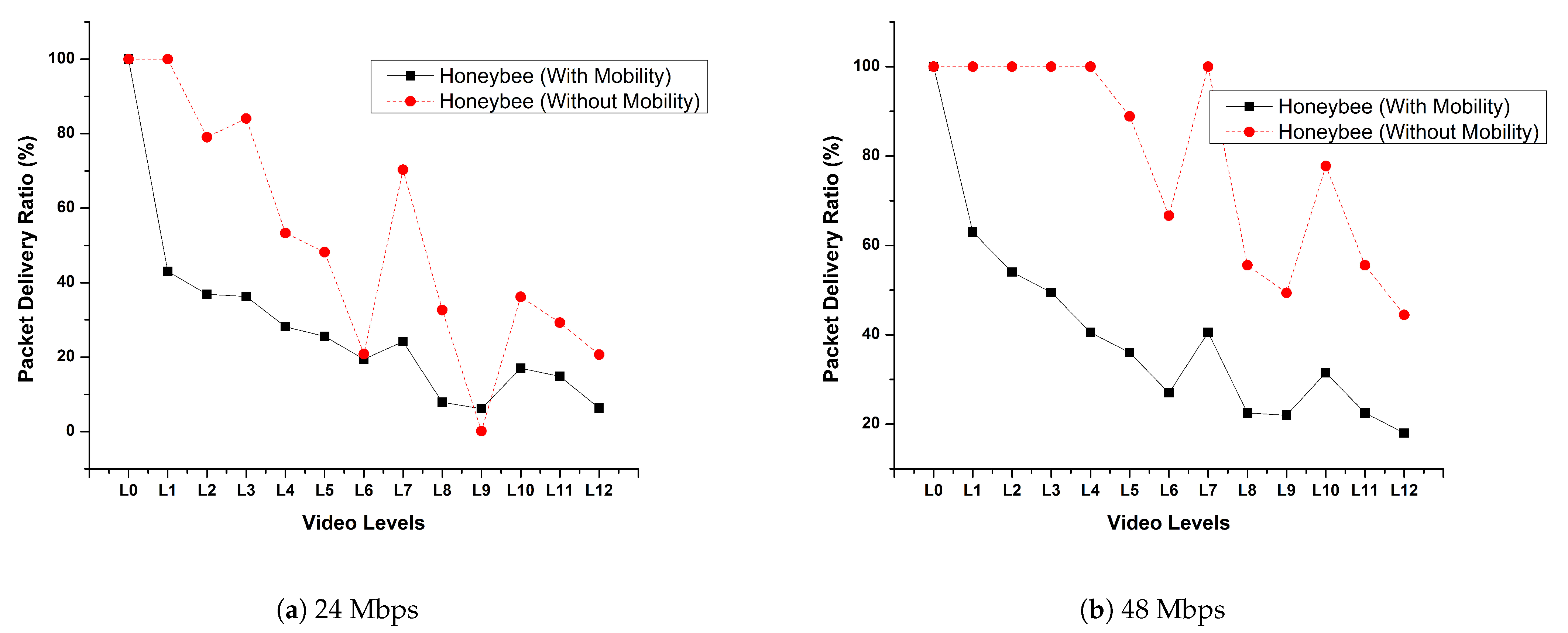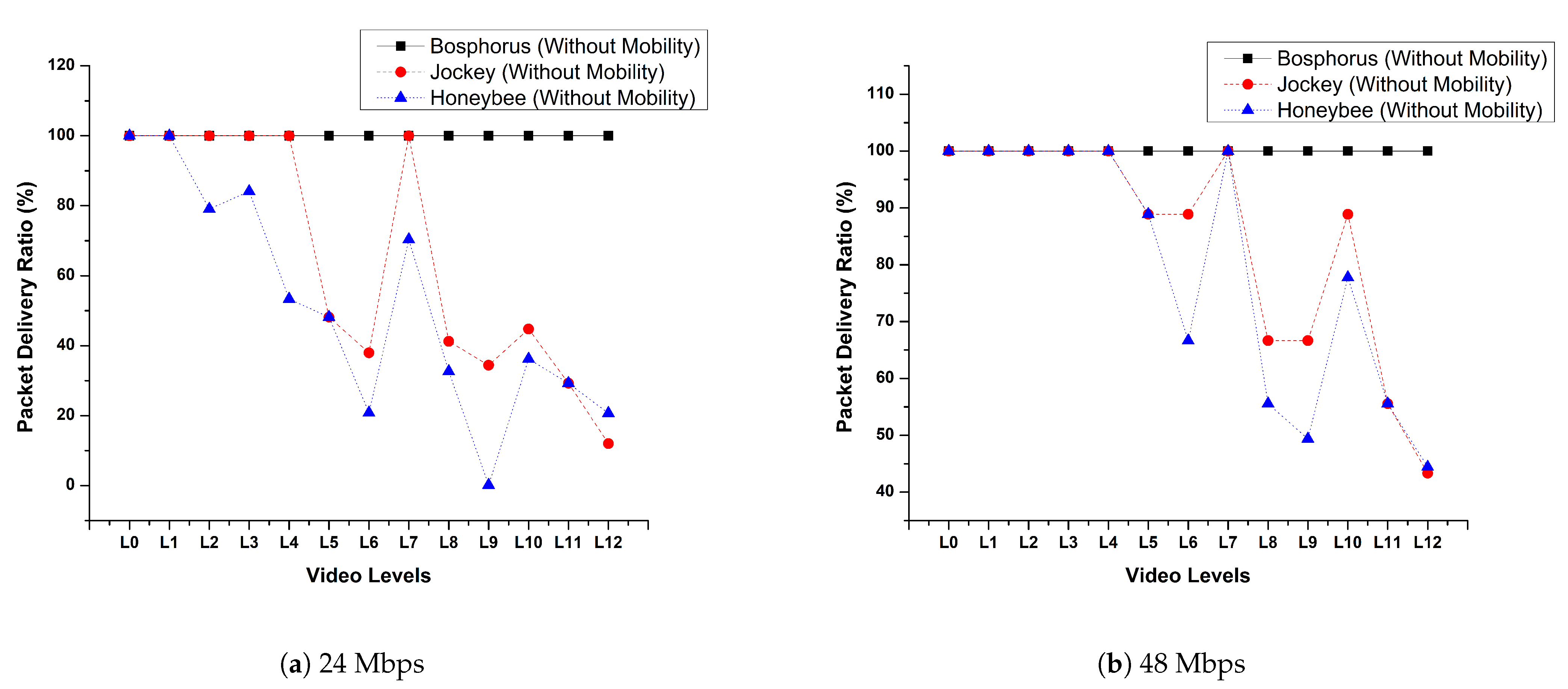Estimation of Adaptation Parameters for Dynamic Video Adaptation in Wireless Network Using Experimental Method
Abstract
:1. Introduction
2. Scalable Video Coding (SVC) an Extension to H.264/Advanced Video Coding (AVC)
Media Aware Network Elements (MANE)
3. Related Works
4. Scalable Video Streaming over Wireless Network
- Node Mobility: The nodes in a wireless network are free to move and that leads to disruption in the communication. The node mobility affects the bandwidth availability between the source and receiver. The change in the bandwidth degrades the quality of the communication.
- Routing Overhead: The routing algorithms in the wireless network use the periodic exchange of messages to monitor and manage the routes. These management messages consume network resources, hence decreasing the resource availability for the data transmission. In addition, the frequent update of the route in the wireless environment leads to the dropping of data packets.
- Motion Levels: The movements of an object in the video sequences influence the encoding and decoding of the video data. The increase in the objects’ motion lead high bitrate of the video data. Hence, that is also an important parameter that needs to be considered in video communication over a bandwidth-constrained network.
- Estimation of Adaptation Parameters: The estimation of the adaptation parameters considering the latter said dynamic conditions is one of the research challenges.
5. Experimentation and Discussion
6. Conclusions
Author Contributions
Funding
Institutional Review Board Statement
Informed Consent Statement
Data Availability Statement
Conflicts of Interest
References
- Li, D.; Pan, J. Performance Evaluation of Video Streaming over Multi-Hop Wireless Local Area Networks. Trans. Wirel. Commun. 2010, 9, 338–347. [Google Scholar] [CrossRef]
- Xing, M.; Xiang, S.; Cai, L. A Real-Time Adaptive Algorithm for Video Streaming over Multiple Wireless Access Networks. IEEE J. Sel. Areas Commun. 2014, 32, 795–805. [Google Scholar] [CrossRef] [Green Version]
- Qiao, X.; Wang, H.; Tan, W.; Vasilakos, A.V.; Chen, J.; Blake, M.B. A survey of applications research on content-centric networking. China Commun. 2019, 16, 122–140. [Google Scholar] [CrossRef]
- Kuo, W.; Kaliski, R.; Wei, H. A QoE-Based Link Adaptation Scheme for H.264/SVC Video Multicast Over IEEE 802.11. IEEE Trans. Circuits Syst. Video Technol. 2015, 25, 812–826. [Google Scholar] [CrossRef]
- Wiegand, T.; Sullivan, G.J.; Bjontegaard, G.; Luthra, A. Overview of the H.264/AVC video coding standard. IEEE Trans. Circuits Syst. Video Technol. 2003, 13, 560–576. [Google Scholar] [CrossRef] [Green Version]
- Schwarz, H.; Marpe, D.; Wiegand, T. Overview of the Scalable Video Coding Extension of the H.264/AVC Standard. IEEE Trans. Circuits Syst. Video Technol. 2007, 17, 1103–1120. [Google Scholar] [CrossRef] [Green Version]
- Ramakrishna, M.; Karunakar, A.K. Estimation of Scalable Video adaptation parameters for Media Aware Network Elements. In Proceedings of the 2014 Sixth International Conference on Communication Systems and Networks (COMSNETS), Bangalore, India, 6–10 January 2014; pp. 1–4. [Google Scholar]
- JSVM Software Manual. 2006. Available online: http://0-scholar-google-com.brum.beds.ac.uk/scholar?hl=en&btnG=Search&q=intitle:JSVM+Software+Manual#0 (accessed on 15 March 2021).
- OMNeT++ Discrete Event Simulator. Available online: http://web.scalable-networks.com/content/exata (accessed on 15 March 2021).
- Sullivan, G.J.; Ohm, J.; Han, W.; Wiegand, T. Overview of the High Efficiency Video Coding (HEVC) Standard. IEEE Trans. Circuits Syst. Video Technol. 2012, 22, 1649–1668. [Google Scholar] [CrossRef]
- Team, J.V.E. Versatile Video Coding. Available online: https://jvet.hhi.fraunhofer.de/ (accessed on 15 March 2021).
- Zahariadis, T.B.; Lamy-Bergot, C.; Schierl, T.; Grüneberg, K.; Celetto, L.; Timmerer, C. Content Adaptation Issues in the Future Internet. In Towards the Future Internet—A European Research Perspective; Tselentis, G., Domingue, J., Galis, A., Gavras, A., Hausheer, D., Krco, S., Lotz, V., Zahariadis, T.B., Eds.; IOS Press: Amsterdam, The Netherlands, 2009; pp. 283–292. [Google Scholar] [CrossRef]
- Gardikis, G.; Xilouris, G.; Kourtis, A.; Negru, D.; Chen, Y.; Anapliotis, P.; Pallis, E. Media Ecosystem deployment in a content-aware Future Internet architecture. In Proceedings of the 2011 IEEE Symposium on Computers and Communications (ISCC), Kerkyra, Greece, 28 June–1 July 2011; pp. 544–549. [Google Scholar]
- Borcoci, E.; Negru, D.; Timmerer, C. A Novel Architecture for Multimedia Distribution Based on Content-Aware Networking. In Proceedings of the 2010 Third International Conference on Communication Theory, Reliability, and Quality of Service, Athens, Greece, 13–19 June 2010; pp. 162–168. [Google Scholar]
- Wang, Z.J.; Chan, S.P.; Kok, C.W. Receiver-Buffer-Driven Layered Quality Adaptation for Multimedia Streaming. In Proceedings of the Conference Record of the Thirty-Ninth Asilomar Conference on Signals, Systems and Computers, Pacific Grove, CA, USA, 30 October–2 November 2005; pp. 1235–1239. [Google Scholar] [CrossRef]
- Guo, C.; Cui, Y.; Ng, D.W.K.; Liu, Z. Multi-Quality Multicast Beamforming With Scalable Video Coding. IEEE Trans. Commun. 2018, 66, 5662–5677. [Google Scholar] [CrossRef]
- An, R.; Liu, Z.; Ji, Y. SVC-based video streaming over highway vehicular networks with base layer guarantee. In Proceedings of the 2017 IFIP/IEEE Symposium on Integrated Network and Service Management (IM), Lisbon, Portugal, 8–12 May 2017; pp. 1168–1173. [Google Scholar] [CrossRef]
- Khan, A.; Mkwawa, I.; Sun, L.; Ifeachor, E. QoE-Driven Sender Bitrate Adaptation Scheme for Video Applications over IP Multimedia Subsystem. In Proceedings of the 2011 IEEE International Conference on Communications (ICC), Kyoto, Japan, 5–9 June 2011; pp. 1–6. [Google Scholar] [CrossRef]
- Salva-Garcia, P.; Alcaraz-Calero, J.M.; Wang, Q.; Arevalillo-Herráez, M.; Bernal Bernabe, J. Scalable Virtual Network Video-Optimizer for Adaptive Real-Time Video Transmission in 5G Networks. IEEE Trans. Netw. Serv. Manag. 2020, 17, 1068–1081. [Google Scholar] [CrossRef]
- Zhan, C.; Hu, H.; Sui, X.; Liu, Z.; Wang, J.; Wang, H. Joint Resource Allocation and 3D Aerial Trajectory Design for Video Streaming in UAV Communication Systems. IEEE Trans. Circuits Syst. Video Technol. 2020. [Google Scholar] [CrossRef]
- Yuan, H.; Hu, X.; Hou, J.; Wei, X.; Kwong, S. An Ensemble Rate Adaptation Framework for Dynamic Adaptive Streaming Over HTTP. IEEE Trans. Broadcast. 2020, 66, 251–263. [Google Scholar] [CrossRef] [Green Version]
- Xie, G.; Jin, X.; Xie, L.; Chen, H. A Quality-driven Bit Rate Adaptation Method for Dynamic Adaptive Streaming over HTTP. In Proceedings of the 2018 10th International Conference on Wireless Communications and Signal Processing (WCSP), Hangzhou, China, 18–20 October 2018; pp. 1–6. [Google Scholar] [CrossRef]
- Wang, Z.; Jiang, X. A QoE-Driven Rate Adaptation Approach for Dynamic Adaptive Streaming Over HTTP. In Proceedings of the 2019 International Conference on Computing, Networking and Communications (ICNC), Honolulu, HI, USA, 18–21 February 2019; pp. 224–229. [Google Scholar] [CrossRef]
- Gohar, A.; Lee, S. Multipath Dynamic Adaptive Streaming over HTTP Using Scalable Video Coding in Software Defined Networking. Appl. Sci. 2020, 10, 7691. [Google Scholar] [CrossRef]
- Pu, W.; Zou, Z.; Chen, C.W. Video adaptation proxy for wireless Dynamic Adaptive Streaming over HTTP. In Proceedings of the 2012 19th International Packet Video Workshop (PV), Amherst, MA, USA, 21 June 2012; pp. 65–70. [Google Scholar] [CrossRef]
- Kim, S.; Yun, D.; Chung, K. Video quality adaptation scheme for improving QoE in HTTP adaptive streaming. In Proceedings of the 2016 International Conference on Information Networking (ICOIN), Kota Kinabalu, Malaysia, 13–15 January 2016; pp. 201–205. [Google Scholar] [CrossRef]
- Tian, G.; Liu, Y. Towards Agile and Smooth Video Adaptation in HTTP Adaptive Streaming. IEEE/ACM Trans. Netw. 2016, 24, 2386–2399. [Google Scholar] [CrossRef]
- Xiang, S.; Cai, L.; Pan, J. Adaptive Scalable Video Streaming in Wireless Networks. In Proceedings of the 3rd Multimedia Systems Conference, MMSys’12, New York, NY, USA, 1 January 2012; pp. 167–172. [Google Scholar] [CrossRef]
- Zhou, H.; Wang, X.; Liu, Z.; Ji, Y.; Yamada, S. Resource Allocation for SVC Streaming Over Cooperative Vehicular Networks. IEEE Trans. Veh. Technol. 2018, 67, 7924–7936. [Google Scholar] [CrossRef]
- Chen, B.W.; Ji, W.; Jiang, F.; Rho, S. QoE-Enabled Big Video Streaming for Large-Scale Heterogeneous Clients and Networks in Smart Cities. IEEE Access 2016, 4, 97–107. [Google Scholar] [CrossRef]
- Awobuluyi, O.; Nightingale, J.; Wang, Q.; Calero, J.M.A.; Grecos, C. In-network adaptation of SHVC video in software-defined networks. In Real-Time Image and Video Processing 2016; Kehtarnavaz, N., Carlsohn, M.F., Eds.; International Society for Optics and Photonics, SPIE: Bellingham, WA, USA, 2016; Volume 9897, pp. 89–96. [Google Scholar] [CrossRef]
- Yu, D.; Wang, Y.; Tonoyan, T.; Halldórsson, M.M. Dynamic Adaptation in Wireless Networks Under Comprehensive Interference via Carrier Sense. In Proceedings of the 2017 IEEE International Parallel and Distributed Processing Symposium (IPDPS), Orlando, FL, USA, 29 May–2 June 2017; pp. 337–346. [Google Scholar]
- Quinlan, J.J.; Zahran, A.H.; Sreenan, C.J. Efficient Delivery of Scalable Video Using a Streaming Class Model. Information 2018, 9, 59. [Google Scholar] [CrossRef] [Green Version]
- Perkins, C.E.; Royer, E.M. Ad-hoc on-demand distance vector routing. In Proceedings of the Second IEEE Workshop on Mobile Computing Systems and Applications, Proceedings WMCSA’99, New Orleans, LA, USA, 25–26 February 1999; pp. 90–100. [Google Scholar]
- Ultra Video Group—Tampere University. Available online: http://ultravideo.fi/ (accessed on 15 March 2021).









| Layer | Resolution (W × H) | Framerate (fps) | Bosphorus Bitrate (kbps) | Jockey Bitrate (kbps) | Honeybee Bitrate (kbps) | (D,T,Q) |
|---|---|---|---|---|---|---|
| L0 | 864 × 480 | 15 | 1229.60 | 4585.00 | 7947.00 | (0,0,0) |
| L1 | 864 × 480 | 30 | 1404.00 | 7781.00 | 13,055.00 | (0,1,0) |
| L2 | 864 × 480 | 15 | 3083.00 | 9354.00 | 15,548.00 | (0,0,1) |
| L3 | 864 × 480 | 30 | 3484.00 | 15,636.00 | 25,340.00 | (0,1,1) |
| L4 | 1280 × 720 | 15 | 3765.00 | 11,729.00 | 18,140.00 | (1,0,0) |
| L5 | 1280 × 720 | 30 | 4370.00 | 19,780.00 | 27,980.00 | (1,1,0) |
| L6 | 1280 × 720 | 60 | 4610.00 | 21,210.00 | 28,460.00 | (1,2,0) |
| L7 | 1280 × 720 | 15 | 5875.00 | 14,024.00 | 20,840.00 | (1,0,1) |
| L8 | 1280 × 720 | 30 | 6758.00 | 23,670.00 | 30,750.00 | (1,1,1) |
| L9 | 1280 × 720 | 60 | 7154.00 | 25,810.00 | 31,340.00 | (1,2,1) |
| L10 | 1920 × 1088 | 15 | 6095.00 | 17,150.00 | 23,030.00 | (2,0,0) |
| L11 | 1920 × 1088 | 30 | 7190.00 | 28,600.00 | 32,990.00 | (2,1,0) |
| L12 | 1920 × 1088 | 60 | 7756.00 | 31,960.00 | 33,720.00 | (2,2,0) |
| Simulation area (m × m) | 1000 × 1000 |
| Simulation time (s) | 100 |
| Number of nodes | 25 |
| MAC layer protocol | IEEE 802.11 |
| Transmission range (m) | 200 |
| Maximum velocity (m/s) | 25 |
| Physical Wireless Layer | IEEE 802.11b |
| Routing Protocol | AODV |
| Bandwidth between links (Mbps) | 24, 48 |
| Parameter | Scalable Video Layer |
|---|---|
| 24 Mbps | L1 (480p) |
| 48 Mbps | L4 (720p) |
| Parameter | 24 Mbps | 48 Mbps |
|---|---|---|
| Without Mobility | L7 (720p) | L10 (1080p) |
| With Mobility | L1 (480p) | L4 (720p) |
| Parameters | Mobility | Non-Mobility | ||
|---|---|---|---|---|
| 24 Mbps | 48 Mbps | 24 Mbps | 48 Mbps | |
| Low | L11 (1080p) | L12 (1080p) | L12 (1080p) | L12 (1080p) |
| Medium | L2 (480p) | L4 (720p) | L7 (720p) | L10 (1080p) |
| High | L0 (480p) | L0 (480p) | L3 (480p) | L5 (720p) |
Publisher’s Note: MDPI stays neutral with regard to jurisdictional claims in published maps and institutional affiliations. |
© 2021 by the authors. Licensee MDPI, Basel, Switzerland. This article is an open access article distributed under the terms and conditions of the Creative Commons Attribution (CC BY) license (http://creativecommons.org/licenses/by/4.0/).
Share and Cite
Bijur, G.; Mundugar, R.; Mantoor, V.; A Kotegar, K. Estimation of Adaptation Parameters for Dynamic Video Adaptation in Wireless Network Using Experimental Method. Computers 2021, 10, 39. https://0-doi-org.brum.beds.ac.uk/10.3390/computers10040039
Bijur G, Mundugar R, Mantoor V, A Kotegar K. Estimation of Adaptation Parameters for Dynamic Video Adaptation in Wireless Network Using Experimental Method. Computers. 2021; 10(4):39. https://0-doi-org.brum.beds.ac.uk/10.3390/computers10040039
Chicago/Turabian StyleBijur, Gururaj, Ramakrishna Mundugar, Vinayak Mantoor, and Karunakar A Kotegar. 2021. "Estimation of Adaptation Parameters for Dynamic Video Adaptation in Wireless Network Using Experimental Method" Computers 10, no. 4: 39. https://0-doi-org.brum.beds.ac.uk/10.3390/computers10040039







